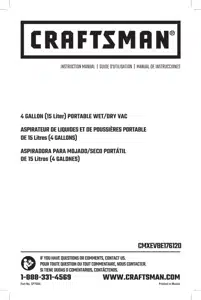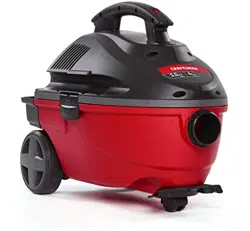Documents: Go to download!
User Manual
- User Manual - (English, French, Spanish)
- Specification Sheet - (English)
- Spec Sheet (web) - (English)

CARTON CONTENTS
(Fig. B)
Remove entire contents of carton. Check each item against the Carton Contents List.
If any parts are damaged or missing, immediately call Customer Service at 1-888-331-4569 (Mexico 001-881-331-4569).
| Key | Description | CMXEVBE176120 4 Gallon (15 Liter) |
| A | Vac Assembly | 1 |
| B | Tool Caddy | 1 |
| C | Caster | 1 |
| D | Wheels | 2 |
| E | Hose Assembly | 1 |
| F | Car Nozzle | 1 |
| G | Sofa Brush | 1 |
| H | Crevice Tool | 1 |
| I | Extension Wands | 2 |
| J | Bag Assembly of Screws | 4 |
| K | Instruction Manual | 1 |
Filter may already be assembled.
NOTE: See Repair Parts List for Part Number.
Tools Required:
Phillips Screwdriver
INSTALLATION
Tool Caddy Assembly (Fig. C)
Locate the Tool Caddy and the Bag Assembly with four screws in the carton. The Tool Caddy is designed to fit on the back of the 4-Gallon (15 Liter) Drum.
NOTE: The Tool Caddy MUST BE assembled to the Vac BEFORE fastening the Wheels.
- Remove the Powerhead from the Drum and set aside.
- Turn the Drum upside down on a flat surface.
- Turn the Tool Caddy upside down and align to the back of the Drum.
- Install the Four Screws in the allotted Holes using a Phillips Screwdriver. Tighten Screws until snug. Do not over tighten as this may tend to deform the Caddy.
- Replace and relatch the Powerhead Assembly onto the Drum
Wheels/Caster Assembly
NOTE: The Tool Caddy MUST BE assembled to the Vac BEFORE fastening the Wheels.
Locate the Two Wheels and the Caster in the carton.
Caster Assembly (Fig. D):
1. Insert the Caster into the Bottom of the Drum, as shown.
2. Push the Caster until the Flange on the Caster Stem is inserted all the way into the Socket. You will hear the Flange snap into the Socket. The Caster will swivel easily when positioning is correct.
Wheels Assembly (Fig. E):
3. Position the Axle side of one of the Wheels into the Drum, as shown. Push Wheel into the Tool Caddy Hub. You will hear the Wheel snap into the Tool Caddy. Repeat for the Second Wheel.
Powerhead Assembly (Fig. F)
1. Line up the Front (label and switch side) of the Powerhead with the Vac Inlet Port located on the Front of the Drum.
NOTE: Powerhead must be aligned with Drum for proper attachment.
2. Place Powerhead on Top of Drum.
3. Be sure Powerhead completely covers the top of the Drum so leakage does not occur.
4. Push down the Latches, and the Powerhead will attach to the Drum.
5. To remove the Powerhead, pull up on the Latches and remove from the Drum.
Insert Hose (Fig. G)
Insert the Hose Locking End of the Hose into the Vac Inlet Port of the Vac. The Hose should snap into place.
To remove the Hose from the Vac, press the Release Button in the Hose Assembly and pull the Hose out of the Vac Inlet Port, as shown.
Accessory Storage
Accessory Tools Storage (Fig. H):
Your Wet/Dry Vac Accessories can be stored in the Tool Caddy mounted on the Drum.
Hose Storage (Fig. I):
The Hose Assembly may be stored by wrapping it around the unit and snapping it into the Recessed Sides.
CAUTION: Do not operate vacuum while the hose is still wrapped around the powerhead assembly in the storage position.
WARNING: Do not put any object into ventilation openings. Do not vacuum with any ventilation openings blocked; keep free of dust, lint, hair or anything that may reduce air flow.
Extension Wands Storage (Fig. J):
The Extension Wands can be stored underneath the Vac by sliding the Tapered End first through the allotted Holes on the back of the Caddy. The Wand stop on the front of the Vac will hold the Extension Wands in place.
OPERATION
WARNING: To reduce the risk of fire, explosion, or damage to Vac:
- Do not leave Vac running while unattended - you may fail to notice important signs indicating abnormal operation such as loss of suction, debris/liquid exiting the exhaust, or abnormal motor noises. Immediately stop using Vac if you notice these signs.
- Do not leave Vac plugged in when not in use.
- Do not continue running when float has cut off suction.
- Sparks inside the motor can ignite airborne flammables. Do not operate Vac near flammable liquids or in areas with flammable gases, vapors, or explosive/airborne dust. Flammable liquids, gases, and vapors include: lighter fluid, solvent-type cleaners, oil-based paints, gasoline, alcohol, and aerosol sprays. Explosive dusts include: coal, magnesium, aluminum, grain, and gun powder.
- Do not vacuum up explosive dusts, flammable liquids, or hot ashes.
- Do not leave sawdust or rags with stain or polyurethane residue inside Vac. Empty drum after picking up these potentially self-heating materials.
WARNING: To reduce the risk of electric shock or injury
- Do not expose to rain or allow liquid to enter motor compartment. Store indoors.
- Do not handle plug, switch, or Vac with wet hands.
- Unplug Vac before servicing. If your Vac is not working as it should, has missing parts, has been dropped, damaged, left outdoors, or dropped into water, call customer service at 1-888-331-4569 (Mexico 001-881-331-4569).
- When using an extension cord, use only outdoor-rated cords that are in good condition. Do not allow the connection to come into contact with liquid.
CAUTION: To reduce the risk of hearing damage, wear ear protectors when using the Vac / Blower for an extended time or in a noisy area.
Polarized Plug
To reduce the risk of electric shock, this Vac has a Polarized Plug (one blade is wider than the other). This Plug will fit in a Polarized Outlet only one way. If the Plug does not fit fully in the Outlet, reverse the Plug. If it still does not fit, contact a qualified electrician to install the proper Outlet. Do not change the Plug in any way.
Power Switch (Fig. K)
After you Plug the Power Cord into the Outlet, turn the Unit on by pushing the Switch from position “O” to position “l”. The symbols used on the Switch Actuator are International “On & Off” Symbols:
Vacuuming Dry Materials
- The Filter must always be in correct position to reduce the risk of leaks and possible damage to Vac.
- When using your Vac to pick up very fine dust, it will be necessary for you to empty the Drum and clean the Filter at more frequent intervals to maintain peak Vac performance.
NOTE: A dry Filter is necessary to pick up dry material. If you use your Vac to pick up dust when the Filter is wet, the Filter will clog quickly and be very difficult to clean. Dry the Filter before storing
Vacuuming Liquids
WARNING: Do not operate without filter cage and float, as they prevent liquid from entering the impeller and damaging the motor. For dry material pick-up, do not operate without the filter in place to reduce the risk of damage to the motor.
WARNING: To reduce the risk of fire or explosion, do not vacuum flammable or combustible liquids, gases or dust.
- When picking up small amounts of liquid the Filter may be left in place.
- When picking up large amounts of liquid, it is recommended, that the Filter be removed. If the Filter is not removed, it will become saturated and misting may appear in the exhaust.
- When the liquid in the Drum reaches a predetermined level, the float mechanism will rise automatically to cut off air-flow. When this happens, turn off the Vac, unplug the Power Cord, and empty the Drum. You will know that the Float has risen because Vac airflow ceases and the motor noise will become higher in pitch, due to increased motor speed.
- After using the Vac to pick up liquids, the Filter must be dried to reduce the risk of possible mildew and damage to the Filter.
IMPORTANT: To reduce the risk of damage to the Vac do not run Motor with Float in raised position.
Emptying the Drum (Fig. L)
WARNING: To reduce the risk of injury from accidental starting, unplug power cord before emptying the drum
- Remove the Powerhead Assembly: Pull Powerhead Assembly Latches outward to release from the Drum.
- Lift the Powerhead Assembly up and away from the Drum.
- Lay Powerhead Assembly upside down on a clean area while emptying the Drum.
- Dump the Drum contents into the proper waste disposal container.
MAINTENANCE
Filter
WARNING: To reduce the risk of injury from accidental starting, unplug power cord before changing or cleaning filter.
IMPORTANT: This Filter is made of high quality paper designed to stop very small particles of dust. The Filter can be used for wet or dry pick up. Handle the Filter carefully when removing to clean or installing it. Creases in the Filter pleats may occur from installation but creases will not affect the performance of the Filter.
Filter Removal and Replacement (Fig. M)
Replacement Filters and Filter Bags are available.
NOTE: See Repair Parts List for Part Number.
IMPORTANT: To reduce the risk of damage to the Blower Wheel and Motor, always reinstall the Filter before using the Vac for dry material pickup.
Filter Removal:
- To remove the Filter for cleaning or replacement, unscrew the Filter Nut from the Filter Cage, remove Filter Plate and lift off Filter.
- To replace the Filter, carefully slide the Filter over the Filter Cage, sliding it over the Center Ring Covering the Three Slots until the Filter stops against the Powerhead.
- Place the Hole in the Filter Plate over the Threaded Screw of the Filter Cage.
- Gently push on the Filter Plate to seat the Rubber Ring of the Filter inside the circular channel of the Filter Plate.
- Place the Filter Nut onto the Threaded Screws and tighten it down. Finger tighten only.
NOTE: Lever of Filter Nut should be away from Plate, as shown.
IMPORTANT: Do not over tighten as this may deform or crack the Filter Cage or Filter Plate.
Filter Cage Replacement (Fig. N)
IMPORTANT: If the Filter Cage needs to be removed, or replaced, use a flat blade screwdriver and insert the blade near one of the Tabs between the Filter Cage and the Center Ring of the Powerhead. Pry the Tab out of the Slot. Tilt the Cage and lift away from the Powerhead. Replace in the following manner:
- Place the Float over the opening in the Center of the Powerhead as shown, laying face down over the Hole.
- Line up Filter Cage Tabs with Slots in the Center Ring of the Powerhead.
- Push on the Filter Cage until the Tabs snap into slots for a secure fit.
Filter Cleaning
Your Filter should be cleaned often to maintain peak Vac performance.
Be sure to dry the Filter before storing or picking up dry debris.
IMPORTANT: After cleaning, check the Filter for tears or small holes. Do not use a Filter with holes or tears in it. Even a small hole can cause a lot of dust to come out of your Vac. Replace it immediately.
Cleaning A Dry Filter
Some removal of dry debris can be accomplished without removing the Filter from the Vac. Slap your hand on top of the Powerhead while the Vac is turned OFF.
For best cleaning results due to accumulated dust, clean the Filter in an open area. Cleaning SHOULD be done outdoors and not in the living quarters.
After Filter removal from Vac, remove the dry debris by gently tapping the Filter against the inside wall of your Dust Drum.
The debris will loosen and fall. For thorough cleaning of dry Filter with fine dust (no debris), run water through it as described under “Cleaning A Wet Filter”.
Cleaning A Wet Filter
After Filter is removed, run water through the Filter from a hose or spigot. Take care that water pressure from the hose is not strong enough to damage Filter.
Cleaning and Disinfecting the Wet/Dry Vac
To keep your Wet/Dry Vac looking its best, clean the outside with a cloth dampened with warm water and mild soap.
To clean the Drum:
- Dump debris out.
- Wash Drum thoroughly with warm water and mild soap.
- Wipe out with dry cloth.
Before prolonged storage or as needed (i.e., waste water pick up) the Drum should be disinfected.
To disinfect the Drum:
- Pour 1 gallon (4 L) of water and 1 teaspoon (5 mL) chlorine bleach into the Drum.
- Let solution stand for 20 minutes, carefully swishing every few minutes, making sure to wet all inside surfaces of the Drum.
- Empty Drum after 20 minutes. Rinse with water until bleach smell is gone. Allow Drum to dry completely before sealing the Motor on the Drum.
Caster
If your Caster is noisy, you may put a drop of oil on the roller shaft to make it quieter.
Storage (Fig. O)
Before storing your Vac, the Dust Drum should be emptied and cleaned. The Power Cord should be wrapped around the Carry Handle and secure the Cord using the Plug Cord Clip. The Hose should be stored as described in this manual. Accessories should be kept in the same area as the Vac so they can be readily available. The Vac should be stored indoors.
WARNING: To assure product SAFETY and RELIABILITY, any other maintenance, repairs and adjustments should be performed by Authorized Service Centers, always using CRAFTSMAN replacement parts.
SERVICE / REPAIR PARTS
4 Gallon (15 Liter) Portable Wet/Dry Vac - Model Number: CMXEVBE176120 Electrical Rating: 120 V~ 7.5 A 60 Hz
WARNING: SERVICING OF DOUBLE-INSULATED WET/DRY VAC
In a double-insulated Wet/Dry Vac, two systems of insulation are provided instead of grounding. No grounding means is provided on a double-insulated appliance, nor should a means for grounding be added. Servicing a double-insulated Wet/Dry Vac requires extreme care and knowledge of the system, and should be done only by qualified service personnel. Replacement parts for a double-insulated Wet/Dry Vac must be identical to the parts they replace. Your double-insulated Wet/Dry Vac is marked with the words “DOUBLE INSULATED” and the symbol (square within a square) may also be marked on the appliance.
To reduce the risk of injury, unplug power cord before servicing the Wet/Dry Vac
WARNING: To reduce the risk of injury, unplug power cord before servicing the Wet/Dry Vac.
WARNING: All disassembly and repairs should be performed by qualified personnel.
Always order by Part Number - Not by Key Number
See other models: CMEW320 CMXEVBE17595 CMCE520B CMXEVBE17596 G940EV-P2

